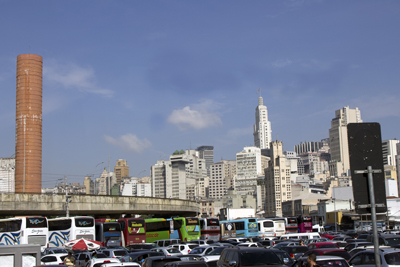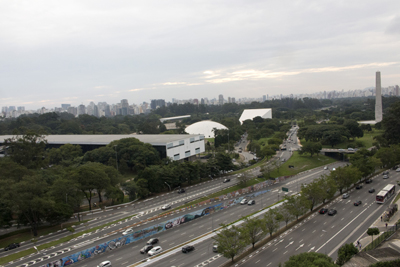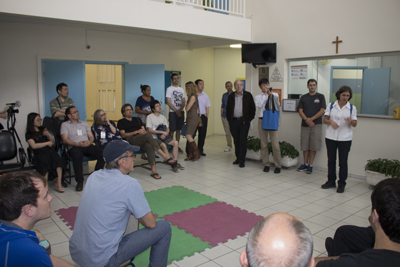Sailing the Times of São Paulo: Collective Effort, Audacity and Multiculturalism
São Paulo, April 18 & 19, 2015
Coffee and palm trees, parks, avenues, buildings, cathedrals, rivers, museums, paintings, graffiti, people, vehicles, football, favelas, sounds and noises; São Paulo is presented to us in a shocking, monumental and polychronic way: we are introduced at once into its past and its present, we access its history while we understand how it came into being, in the words of our expert guide and host of the ICA in São Paulo, Professor Martin Grossman.
 We began the scientific and cultural tour furrowing the city by bus, driving through kilometers of cement, cars and palm trees. The contrast between the green tones of the dense vegetation and the gray tones of the magnificent buildings creates a score of simultaneous dissonance and harmony. The absence of advertising in the streets allows us to appreciate in detail the amalgam between centenary architecture and contemporary industrial design.
We began the scientific and cultural tour furrowing the city by bus, driving through kilometers of cement, cars and palm trees. The contrast between the green tones of the dense vegetation and the gray tones of the magnificent buildings creates a score of simultaneous dissonance and harmony. The absence of advertising in the streets allows us to appreciate in detail the amalgam between centenary architecture and contemporary industrial design.
After visiting the Independence Park and the surrounding palaces, one can understand that the urbanization of São Paulo was a clear attempt to domesticate nature. The transformation of rivers into underground cement canals, of native forests into enclosed parks and of hills into uncountable edifices expresses the materiality of the ideals of an aristocracy that believed wilderness should be tamed, that the indomitable nature of the tropics could be controlled. This made it possible to create the city, to dominate it and to inhabit it.
Brazil is rooted in aboriginal cultures that date more than 12,000 years. Besides the hundreds of indigenous Amerindian and African peoples that faced – and still face – colonization, many ethnicities took part in the construction of a globalized mega-nation. The cannibalism attributed to some Amazonian tribes can be interpreted today as a metaphor of the multicultural exchange that traverses the city as one of its identifiable features: feeding on other cultures to build one’s own. Martin mentioned this idea to explain the history of São Paulo’s cultural heritage, from the architecture of public buildings to the structure and design of the Schools of the University of São Paulo.
This idea turned up again later, when we listened, through the hands of young pianists from USP, the music of Brazilian composer Alexandre Levy (1864-1892). Listening to the piece “Brazilian Tango,” I recognized the 2x4 tempo of Buenos Aires’ tango milonga, and the mixture of tango and classical piano referred me to Piazzolla, the great Argentine composer who was able to devour the rigid tradition of the tango and create a new musical being, called the “New Tango,” integrating timbres and rhythms of classical music and jazz.
I then thought of the artistic anthropophagy required to compose art or science beyond the traditions and schools that form and limit us, what in science often defines the epistemological threshold – or paradigm – from which it is not easy to escape, or even to face. To create art beyond the limits of traditions and contexts of epoch was the idea that Levy’s music conveyed to me, resonating with the spirit of the ICA event of bringing various researchers from around the world to creatively discuss new ways to investigate the ubiquitous problem of Time, as well as the challenge of rethinking academic life in its social and academic contexts.
 São Paulo has reinvented itself several times thanks to its cultural cannibalism – and continues to do so. When visiting USP’s Museum of Contemporary Art (MAC-USP), we witnessed, in addition to a formidable art exhibit and a panoramic view of Ibirapuera Park, a performance of musical anthropophagy: the mega-city noise filtered through the pharaonic walls of the museum and turned into quadraphonic sound, a poetry spiral that repeated itself in changing patterns, as in a Bach fugue, but implemented by electronic pulses, cables and magnetic speakers. The sonic culture of São Paulo, nurtured on samba and on baroque music, has managed to digest the dissonances and arrhythmias of the 21st century urban jungles, and has also been bold enough to capture its lush fidelity and intercultural language. This is another of the resonances that echo the melody running through the ICA participants in São Paulo: audacity, fidelity, multiculturalism.
São Paulo has reinvented itself several times thanks to its cultural cannibalism – and continues to do so. When visiting USP’s Museum of Contemporary Art (MAC-USP), we witnessed, in addition to a formidable art exhibit and a panoramic view of Ibirapuera Park, a performance of musical anthropophagy: the mega-city noise filtered through the pharaonic walls of the museum and turned into quadraphonic sound, a poetry spiral that repeated itself in changing patterns, as in a Bach fugue, but implemented by electronic pulses, cables and magnetic speakers. The sonic culture of São Paulo, nurtured on samba and on baroque music, has managed to digest the dissonances and arrhythmias of the 21st century urban jungles, and has also been bold enough to capture its lush fidelity and intercultural language. This is another of the resonances that echo the melody running through the ICA participants in São Paulo: audacity, fidelity, multiculturalism.
The landmark and scientific imaginaries of São Paulo combine in an intercontinental mode; the ethnic diversity enters and disperses throughout the land, like the rivers that cross the city to reach the entrails of the earth. The landmark imaginaries not only appertain to the hybridization of architectural styles and the multiple forms of urban expressions, but are also part of the communities and neighborhoods of Portuguese, Japanese, Bolivian, Paraguayan, and Korean populations, among many others. São Paulo is, in this sense, a multiethnic nation in itself, bringing together nationalities from all over the planet.
Regarding scientific imaginaries, the University of São Paulo managed to further the education of its first graduates in different universities of the US and Europe to plan the creation of its own faculties, leveraging their vast experience, which in turn was used to develop public policies that gave voice to the demands of a city in constant growth. This pluri-ethnic and academic landscape that allowed USP to grow over the last 80 years and establish research centers like the IEA frames the Atlantic horizon where the participants of the ICA may conceive and develop a new dawn of science without borders (national, ethnic, academic or economic).
 We ended the two days of our exhausting paulista tour by visiting the Nutritional Education and Recovery Center in the Vila Medeiros favela. As we listened to the celebrations with shouts and pyrotechnics coming from the houses of the goals of the match between Palmeiras and Corinthians, I read a 50-meter graffiti on a huge wall that captivated me: “We will not be forever, but we will be always sailing the times of eternity.” An excellent phrase not only to reflect upon the philosophical dilemma of time, life and eternity, but also to make us willing to create change and remain positive even in the most hostile sociocultural conditions, or in the least expected places. The ICA in São Paulo inspires us to be strong from each of our own small places in the world and to be aware of the collective effort that means being part of an intercontinental network of collaborative academic work.
We ended the two days of our exhausting paulista tour by visiting the Nutritional Education and Recovery Center in the Vila Medeiros favela. As we listened to the celebrations with shouts and pyrotechnics coming from the houses of the goals of the match between Palmeiras and Corinthians, I read a 50-meter graffiti on a huge wall that captivated me: “We will not be forever, but we will be always sailing the times of eternity.” An excellent phrase not only to reflect upon the philosophical dilemma of time, life and eternity, but also to make us willing to create change and remain positive even in the most hostile sociocultural conditions, or in the least expected places. The ICA in São Paulo inspires us to be strong from each of our own small places in the world and to be aware of the collective effort that means being part of an intercontinental network of collaborative academic work.
